Page 321 of 352 pages « First < 319 320 321 322 323 > Last »
Abolition commemorative plate

Description:
Commemorative plate supporting Abolition (the end of the slave trade). The plate shows a slave owner (possibly the character Simon Legree from the book Uncle Toms Cabin by Harriet Beecher Stowe) whipping his slave.
Contributed by John Judkyn Memorial.
Date: unknown
Copyright: The American Museum in Britain, Bath
Object ID:70.103
Sale certificate of a slave
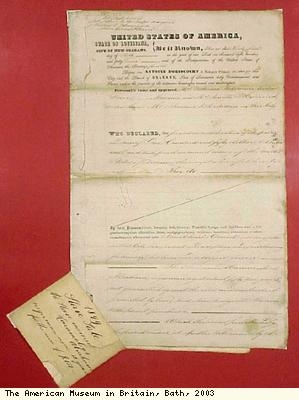
Description:
Sale certificate of a slave called Haramatias Abraham to Jean Charles David.
Contributed by John Judkyn Memorial.
Date: 1849
Copyright: The American Museum in Britain, Bath
Object ID:70.125
Tobacco box

Description:
Tobacco box. Round tobacco box and lid made of lead depicting the head of a black man. Inside is a flat, inner lid of lead to press down the tobacco; this is painted in ochre and the top has R Hayes scratched on the reverse.
Contributed by John Judkyn Memorial.
Date: unknown
Copyright: The American Museum in Britain, Bath
Object ID:71.51
View of St Salvador
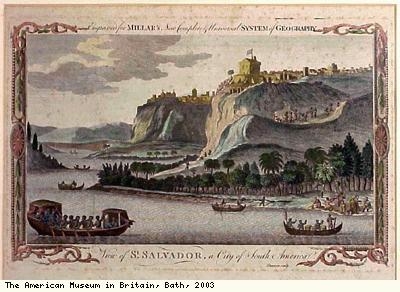
Description:
Print of engraving: View of St Salvador, a City of South America.
Engraved from Millar’s New Complete and Universal System of Geography.
Hand coloured print showing slaves in the 18th century.
Salvador is the third largest city in Brazil and capital of the state of Bahia, South America.
It quickly became the main Brazilian sea port and first capital of Portuguese Brazil; a centre of the sugar industry and the slave trade. From 1500 to 1815, Salvador was Brazil’s busiest port. A significant portion of the sugar from the northeast and gold and diamonds from the mines in the southeast passed through Salvador.
It was a golden age for the town; magnificent homes and churches were built.
Salvador was built on two levels; the cidade alta (upper city); with the Cathedral and administrative buildings and the cidade baixa (lower city); with the forts, docks, and warehouses on the beaches.
It is still divided into upper and lower cities, with a population of 2,250,000 inhabitants. Most of these people are descended from the mixture between black, white and Amerindians.
In Salvador, the African influence in the makeup of Brazilian culture is readily visible. There are dishes called by their African names (caruru, vatapa, acaraji ). There are ceremonies of candombli ; which honour both African deities (gods or goddesses) and Catholic holidays. Capoeira schools exist, where a unique African form of ritualistic fighting is taught.
The main religions in Salvador are Catholicism, Candomble, Protestantism, Espiritism, and most recently Mormons.
It is common for some people to take and believe in aspects from different religions; this probably started when slaves were not allowed to pray to their own gods. They took on surrogate gods to show their owners they were praying to catholic gods; they were actually praying to their own.
This has led to the fact that for almost any catholic saint, there is a corresponding deity; both honoured on the same day.
Contributed by John Judkyn Memorial.
Creator: Millar
Date: 18th century
Copyright: The American Museum in Britain, Bath
Object ID:72.01
Money box

Description:
Mechanical metal money box, cast in the form of a black performer. Representations such as this one were common in America in the early-mid twentieth century.
Contributed by John Judkyn Memorial
Copyright: The American Museum in Britain, Bath
Object ID:72.02
Leather slave whip
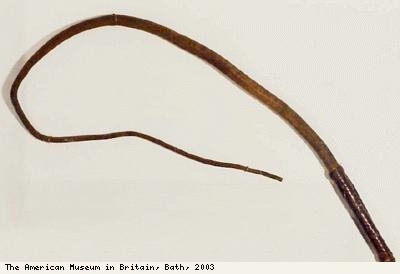
Description:
Leather slave whip.
Contributed by John Judkyn Memorial
Copyright: The American Museum in Britain, Bath
Object ID:72.14
Slave bill of sale
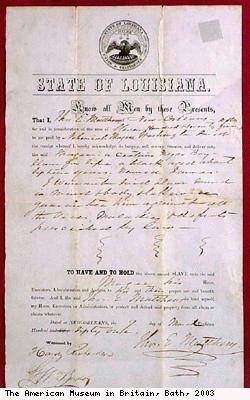
Description:
Slave bill of sale of the slave James by Thomas E Matthews to Nehemiah Magee. Printed document with hand-written additions. Framed.
Contributed by John Judkyn Memorial.
Copyright: The American Museum in Britain, Bath
Object ID:72.100
Pottery bottle or jug
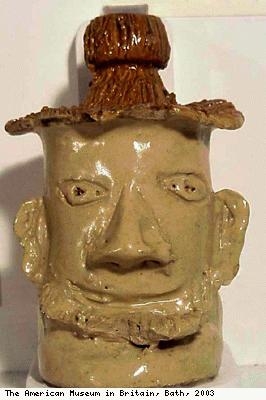
Description:
Slave pottery bottle or jug, in the shape of a head.
Slave pottery was known as Colono Ware.
In America many slaves were trained in various crafts.
It is possible that the face on this bottle represents Abraham Lincoln.
Such jugs may have been made by slaves to protect the souls of the dead. They would have left them in graveyards.
Contributed by John Judkyn Memorial.
Copyright: The American Museum in Britain, Bath
Object ID:72.134
Proclamation of end of slavery

Description:
Document: Proclamation of Emancipation (end of slavery) in America.
Contributed by John Judkyn Memorial.
Copyright: The American Museum in Britain, Bath
Object ID:72.139
Indigo cloth
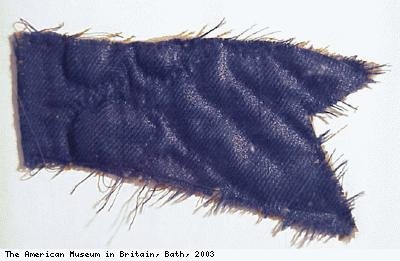
Description:
Piece of indigo cloth.
Indigo is a dark blue dye, native to ancient India and Egypt.
It was first planted in America in the mid 1600s. Planters believed it would yield ten times more profit than tobacco, thus enabling them to take over India’s indigo trade.
It was South Carolina’s main crop from late 1740s – late 1700’s/early 1800s.
Rice took over during the War of Independence, in the late mid 1700s, and by the end of the 18th century, cotton had become Carolina’s main crop.
Contributed by John Judkyn Memorial
Date: c1700s
Copyright: The American Museum in Britain, Bath
Object ID:314?
Page 321 of 352 pages « First < 319 320 321 322 323 > Last »

